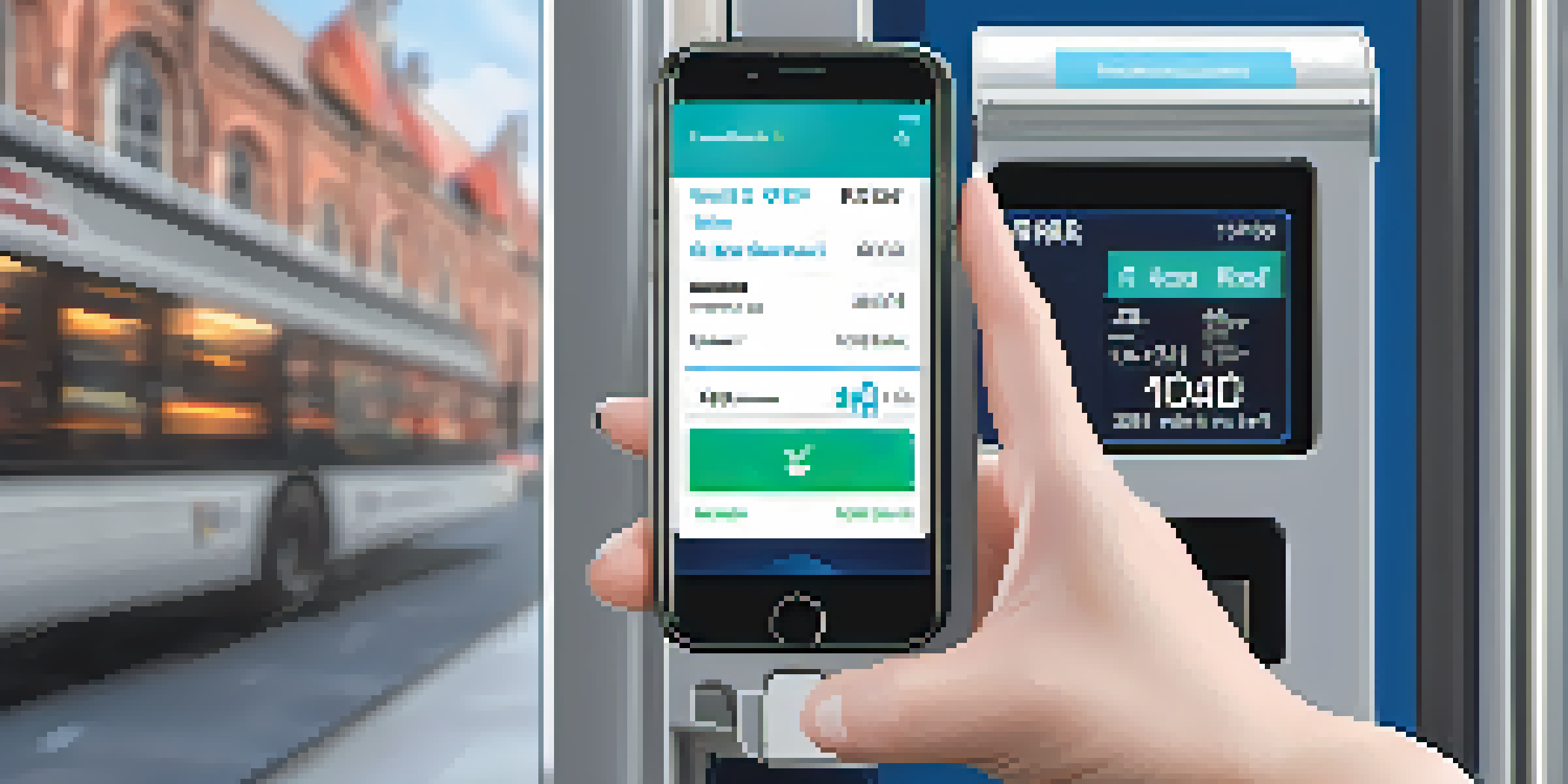Public Transportation Innovations: Moving Towards Sustainability

The Rise of Electric Buses in Urban Areas
Electric buses are transforming public transport in cities worldwide. These eco-friendly vehicles significantly reduce greenhouse gas emissions, making urban travel cleaner. Cities like Los Angeles and London are already investing heavily in electric bus fleets to improve air quality and combat climate change.
Public transport is the backbone of a sustainable city.
Not only do electric buses have lower operational costs over time, but they also offer a quieter ride, enhancing the passenger experience. This shift towards electrification is a crucial step in the evolution of public transportation. By replacing traditional diesel buses with electric alternatives, cities can contribute to a healthier environment.
Furthermore, many cities are exploring the integration of renewable energy sources to power these electric buses. By utilizing solar or wind energy, they can further decrease their carbon footprint. This innovative approach showcases how public transport can lead the charge towards a more sustainable future.
Smart Ticketing Systems: Convenience Meets Sustainability
Smart ticketing systems are revolutionizing how we access public transport. By allowing users to pay with smartphones or contactless cards, these systems streamline the process and reduce the need for paper tickets. This not only enhances convenience but also contributes to sustainability by minimizing waste.

Cities like Singapore and London have successfully implemented these smart systems, which also gather valuable data on travel patterns. This information can be used to optimize routes and schedules, reducing energy consumption and improving service efficiency. It's a win-win scenario for both passengers and the environment.
Electric Buses Enhance Urban Transport
Electric buses are reducing emissions and improving air quality in cities, making public transit more sustainable.
Moreover, these systems often incorporate features that encourage the use of public transport, like rewards for frequent riders. By making public transit more attractive and accessible, cities can increase ridership, ultimately reducing traffic congestion and emissions. It's all about creating a smarter, greener commuting experience.
Bicycle-Sharing Programs: A Complement to Public Transit
Bicycle-sharing programs are gaining traction as cities seek to promote sustainable transportation. These initiatives provide an easy way for people to combine cycling with public transit, reducing reliance on cars. By offering affordable and accessible bike rentals, cities can encourage healthier, greener commuting habits.
The best way to predict the future is to create it.
For example, cities like Paris and Amsterdam have successfully integrated bike-sharing with their public transport networks, allowing users to seamlessly transition from bike to bus or train. This synergy not only promotes a healthier lifestyle but also helps alleviate traffic congestion and emissions. The result is a more interconnected and efficient urban transport system.
Additionally, many bike-sharing programs are increasingly adopting electric bikes, making cycling more accessible to a wider range of people. This innovation opens up new possibilities for commuting and further supports the sustainability goals of urban areas. It's a simple yet impactful way to enhance public transport and promote eco-friendly travel.
Autonomous Vehicles: The Future of Public Transit
The advent of autonomous vehicles (AVs) is poised to reshape public transportation dramatically. These self-driving cars and shuttles promise to enhance safety, reduce traffic congestion, and provide more efficient service. Imagine hopping into a driverless shuttle that takes you to your destination without the hassle of navigating busy streets.
Cities like San Francisco and Phoenix are already testing autonomous shuttle programs in designated areas. These trials offer valuable insights into how AVs can integrate with existing public transport systems. By providing first and last-mile connectivity, AVs can help fill gaps in service and encourage more people to use public transit.
Smart Ticketing Boosts Transit Use
Smart ticketing systems streamline access to public transport while minimizing waste and encouraging ridership.
While there are still regulatory and technological hurdles to overcome, the potential for AVs to contribute to sustainability is enormous. By optimizing routes and minimizing energy consumption, autonomous public transport could lead to significant reductions in emissions. It's an exciting glimpse into the future of urban mobility.
Green Infrastructure: Eco-Friendly Transit Solutions
Investing in green infrastructure is essential for sustainable public transportation systems. This includes building energy-efficient transit hubs, incorporating green roofs, and utilizing sustainable materials. These initiatives not only reduce the environmental impact of public transit facilities but also create pleasant spaces for commuters.
Cities like Copenhagen have embraced green infrastructure by designing transit stations that blend with their natural surroundings. Incorporating plants and natural elements not only enhances aesthetics but also improves air quality and reduces urban heat. It's a holistic approach that considers both functionality and the environment.
Moreover, integrating features like rainwater harvesting and solar panels into transit facilities can significantly decrease energy consumption. This commitment to sustainability sets a strong example for other cities to follow. Ultimately, green infrastructure is about creating a more resilient and eco-friendly public transportation network.
Multimodal Transportation: Seamless Connections for All
Multimodal transportation emphasizes the importance of integrating various transport modes to create a seamless commuting experience. By combining buses, trains, bikes, and even ridesharing services, cities can offer comprehensive solutions that cater to diverse needs. This approach not only enhances convenience but also promotes sustainability by encouraging the use of public transport.
Cities like Amsterdam excel in multimodal transport, connecting bikes with trams and trains to facilitate easy transfers. This interconnectedness encourages residents to choose public transport over personal vehicles, reducing traffic and emissions. By breaking down barriers between different transport modes, cities can create a more efficient and sustainable transit system.
Multimodal Transit Promotes Connectivity
Integrating various transport modes creates seamless commuting experiences and encourages sustainable travel habits.
Moreover, technology plays a vital role in making multimodal transportation more accessible. Mobile apps that provide real-time information about schedules, routes, and connections empower users to make informed decisions. By embracing technology and integration, cities can pave the way for a more sustainable and user-friendly public transportation landscape.
Public Awareness and Community Engagement in Transit Innovations
Public awareness and community engagement are crucial for the success of transportation innovations. Educating citizens about new sustainable initiatives fosters a culture of sustainability and encourages more people to use public transit. When individuals understand the benefits, they are more likely to embrace changes in their commuting habits.
Cities can host workshops, informational campaigns, or community events to engage residents and share the advantages of new public transport options. By involving the community in the decision-making process, cities can also gather valuable feedback that helps shape future innovations. This collaborative approach strengthens the bond between the community and their transit systems.

Furthermore, success stories from early adopters can inspire others to make the switch to more sustainable transportation. By showcasing the positive impact of public transport innovations, cities can cultivate a sense of pride among residents. Ultimately, community engagement is key to fostering a collective commitment to sustainability in public transportation.
The Road Ahead: Challenges and Opportunities for Sustainable Transit
While the innovations in public transportation are promising, challenges remain on the road to sustainability. Funding, infrastructure, and political will are critical factors that can either facilitate or hinder progress. Cities must navigate these complexities to implement and sustain innovative transport solutions effectively.
However, with challenges come opportunities. As technology advances, cities can harness data and analytics to optimize public transit systems. This can lead to improved efficiency, reduced costs, and lower emissions, ultimately benefiting both the environment and commuters. Collaboration between government, industry, and communities is essential for overcoming obstacles and maximizing these opportunities.
In conclusion, the future of public transportation lies in embracing innovation and sustainability. By investing in electric vehicles, smart systems, and community engagement, cities can create a public transit landscape that is not only efficient but also environmentally friendly. The journey towards sustainable public transportation is just beginning, and the possibilities are endless.